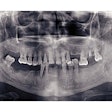
TORONTO - An analysis of data from a recent Canadian health survey did not reveal a significant association between obesity and periodontitis -- despite the fact that previous systematic reviews found at least a 35% increased risk for periodontitis among obese individuals.
A team from the University of Toronto Faculty of Dentistry analyzed data from the 2007-2009 Canadian Health Measures Survey. The survey was launched in 2007, and its staff collect information from individuals through a clinical exam and a series of household interviews.
The goal is to create a database of Canadian information on the prevalence of health issues ranging from obesity to exposure to environmental contaminants, noted senior study investigator Carlos Quiñonez, DMD, PhD, an assistant professor of dental public health at the University of Toronto. The team presented the results February 13 in poster form at the University of Toronto Dental Research Institute's 2013 Research Day.
Dr. Quiñonez and his colleagues focused on data from 2,795 dentate individuals ages 20 to 79 on their worse probing depth and attachment loss for six sites in their mouths, as well as waist circumference and body mass index (BMI; kg/m2).
The researchers used the case definition of periodontitis from the Centers for Disease Control and Prevention and the American Academy of Periodontology: at least two sites with at least 3 mm of clinical attachment loss, and at least two sites with pocket depth (PD) of at least 4 mm or one site with a PD of at least 5 mm; or at least two sites with clinical attachment loss of at least 4 mm; or at least two sites with a PD of at least 5 mm.
The cohort from the Canadian Health Measures Survey was about half female, most were between the ages of 20 and 59 years, and just over 80% were Caucasian.
Once weighted for the age and sex distribution of the Canadian population and after adjusting for the complex survey design, 15% of the people in the sample had periodontitis, including 32% of those ages 60 to 79. The researchers found that 45% had a BMI of less than 24.9, while 35% were overweight -- with a BMI of 25 to 29.9 -- and the remainder were obese, with a BMI of at least 30.
No full-mouth exams
The researchers then adjusted for numerous characteristics, including sex, age, cultural/racial origin, smoking, self-reported diabetes, fasting plasma glucose level and hemoglobin A1c levels -- which are both blood markers for diabetes -- education, income adequacy -- which takes into account household size -- dental insurance status, number of teeth, and dental visit frequency.
They found that there was not a statistically significant relationship between being overweight, obese, or morbidly obese and having periodontitis. In fact, there was a slight, albeit nonstatistically significant, reduction in the odds of having periodontitis among the morbidly obese.
The only factors that were associated with statistically significantly increased odds of having periodontitis were being male, being between 40 and 59 or 60 and 79 years of age, being non-Caucasian, being a past or current smoker, and not having dental insurance.
The investigators believe the lack of a correlation between periodontitis and obesity may be due, in part, to the fact that the prevalence of periodontitis in the cohort was low, at least compared with the 47% prevalence in American adults in a recent analysis of data from the 2009-2010 National Health and Nutrition Examination Survey (Journal of Dental Research, October 2012, Vol. 91:10, pp. 914-920).
The prevalence of periodontitis in the Canadian cohort would probably have been higher if the definition was based on a full-mouth examination, according to Dr. Quiñonez. The Canadian Health Measures Survey only took periodontal measurements at six sites in the mouth.
"The low prevalence in our analysis may also be due to the fact that this was a sample of relatively healthy, young to middle-aged adults with favorable oral health behaviors," he added.
People with periodontitis and obesity have many overlapping characteristics, including older age, being past or current smokers, having diabetes, less education, lower income, not having dental insurance, and having fewer teeth. Thus, the relationship is difficult to precisely pin down and more research is required, noted lead study investigator Sari Hershenfield, DDS, a second-year Master of Science student and periodontology resident.



















